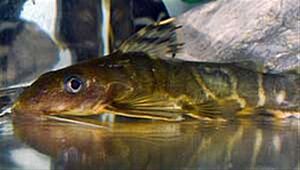Synodontis brichardi facts for kids
Quick facts for kids Synodontis brichardi |
|
|---|---|
 |
|
| Conservation status | |
| Scientific classification | |
| Genus: |
Synodontis
|
| Species: |
brichardi
|
The Synodontis brichardi, also called Brichard's synodontis, is a special type of upside-down catfish. This fish lives only in one place: the fast-moving waters (rapids) of the lower Congo River in the Democratic Republic of the Congo.
A scientist named Max Poll first described this fish in 1959. The first fish he studied came from the Kinsuka rapids. The name brichardi honors Pierre Brichard. He was a person who exported aquarium fish and found this fish first.
Contents
What Does Brichard's Synodontis Look Like?
Like other Synodontis fish, Brichard's synodontis has a strong, bony head. This head bone goes all the way back to its first fin spine. It also has a small, bony bump on its side called a humeral process.
This fish has three pairs of barbels. These are like whiskers around its mouth. One pair is on its upper jaw. Two pairs are on its lower jaw. It has a large, soft fin on its back called an adipose fin. Its tail fin, or caudal fin, is shaped like a fork.
Fins and Spines
The front edges of its back fin (dorsal fin) and side fins (pectoral fins) are very stiff. They are like hard spines. The fish can lift these spines straight out from its body. It can then lock them in place. This helps protect the fish from danger. Small bones help to lock the spines. Once they are up, the fish cannot fold them down by pushing on the tip.
Teeth of the Synodontis
The fish has a special pad of teeth on the front of its upper jaw. These teeth are short and shaped like chisels. On its lower jaw, the teeth are different. They are attached to flexible, stalk-like parts. These teeth are described as "s-shaped" or "hooked."
This fish can grow up to about 15 centimeters (5.9 in) long. Female Synodontis fish are usually a bit bigger than males of the same age.
Where Brichard's Synodontis Lives and What It Does
In the wild, Brichard's synodontis lives in the fast-flowing parts of the lower Congo River. Synodontis fish are generally omnivores. This means they eat both plants and animals. They munch on insect larvae, algae, snails, clams, sponges, and small crustaceans. They also eat the eggs of other fish.
Reproduction and Life Cycle
Scientists do not know much about how most Synodontis fish reproduce. We know that females can carry many eggs. They likely lay their eggs during the flooding season. This usually happens between July and October. During this time, pairs of fish might swim together to lay eggs. Young fish grow very quickly in their first year. After that, their growth slows down as they get older.


